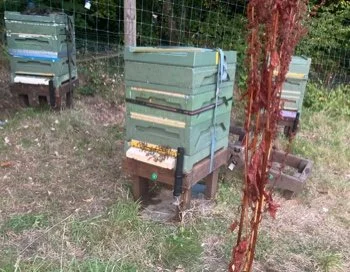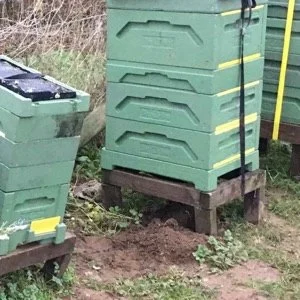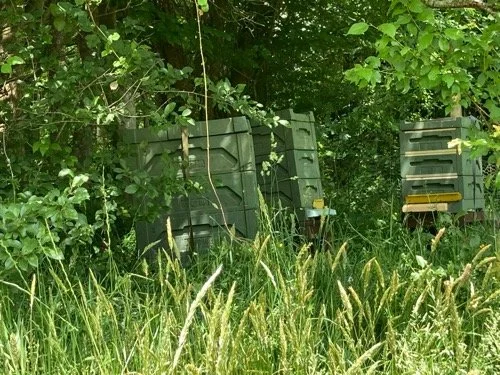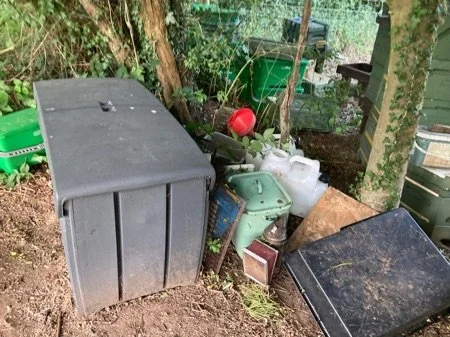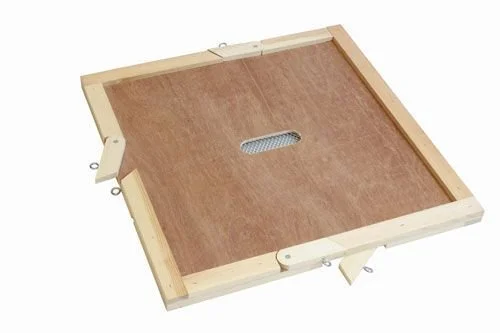
Siting and Moving hives
9 minute read
Safety is paramount. Foragers must find their way home.
Describe what precautions should be taken to prevent honeybees from being a nuisance to neighbours and livestock. Give an elementary description of how to set up an apiary.
Siting an Apiary
An apiary must have five or more hives to survive Asian hornet attacks. Consequently, many beekeepers will have to share apiaries. I’ll ignore that reality.
A queen bee does three things: lays eggs, swarms and dies. If she fails and the colony lacks eggs, it is doomed. It’s not uncommon. If you don’t have a second colony, you will have to do some grovelling to get a frame of eggs or pay a small fortune for a queen, should one be available. So make sure you start with enough room for a second hive. There is a natural tendency for two hives to become 4 and 4 to become 8. So you will need plenty of space. If you want to store poly hives in a shed, don’t, although an empty garage would be okay. Every time a box bumps into something hard, it gets injured.
Home or out-apiary
If you have to drive to an out-apiary, your honey will have a considerable carbon footprint. But I suppose it is widely believed that a car is a necessary extension of one’s legs, so it follows that petrol is a form of food and food is essential for life.
The most fun place to keep bees is in your garden. But it must be suitable. If the hives are well tucked away and there is a good branch for swarms to hang off (particularly if you regularly wipe it with swarm lure wipes), you need not necessarily tell your hysterical neighbour.
Yes, that’s apocryphal. Bees can be defensive like a mastiff. Would you ask for permission before getting what turns out to be a jumping, escape artist, over-protective dog? In comparison, placid bees pose no risk. But they may decide to swarm into your neighbour’s garden, and your neighbours could find bees frightening.
Alternatively, win over your neighbours with promises of honey, but be circumspect; they may have diabetes, consider insects disgusting stinging things, or not wild about honey. You could use the “good for the world” card if extremely few apiaries are near your home. Explain swarming to your neighbours and that swarming bees are gentle bees (hopefully). Generally, forewarned is forearmed.
For example, if your neighbour is severely allergic to bee stings, you may have to explain that if they already have bees tending their flowers, they won’t get any more bees just because you keep them. But be circumspect. If your neighbour puffs up and dies, you won’t feel great. So it would be better to find another site.
Chief Considerations:
safe
sheltered
countryside hazards
water
secluded
forage
road access
storage
orientation
Space: With two hives, they can sit side by side, their entrances facing opposite directions. Your apiary must have enough space to dissemble a hive into three piles. Enough space between hives equates to how much space you need to move around them comfortably. If you use British Standard hives, I recommend initially orienting them cold-way, so an experienced beekeeper can inspect them with you. The area surrounding your apiary will determine your lneed to exterminate less-than-perfect colonies. If your neighbours are close, you may wish to dispatch any colony with bees that follow you 2 metres after an inspection. If this is your criteria, you will kill plenty of colonies.
For example, my bees fly over a farmer’s track seven meters from my hives. My storage box is four meters or more from my hives. If the bees hound me after my inspections, so I cannot remove my suit, they complain too much. If I have a spare queen and requeening does not make an immediate difference, I destroy the cantankerous colony. I cannot wait and see. It’s not nice to kill a colony, but I cannot take risks. Usually, I can wander one foot away from my hives without wearing a suit, but despite this, on average, I have to dispatch a colony every year. Bees can be gentle until disturbed and subsequently prone to sting for the rest of the day.
Orientation
Wooden hives are best put in the shade to reduce the energy the bees must expend to control the internal milieux. Poly hives likewise, but both hive types seem to do okay in the sun. However, bees in wooden hives invariably beard in the 20s °C .Bees in poly hives may beard in the 30s °C, (I’ve only seen it once or twice).
However, you must ensure that you can hold a frame up to eye level where sunlight or bright light will shine on it from above or over your shoulder. Unless you pay attention to this, I assure you that you will not be able to inspect your bees properly; you will be unable to see eggs, just black holes. Subsequently, your colonies will swarm, and you will feel a failure.
Wooden hives warm up rapidly in the morning sun, so position their entrance facing Southeast so they get off to an early start. This sounds plausible, and research in an Arizonan climate is favourable. Poly hives don’t need the sun so much as they are warm inside.
If you don’t have much space, the entrance of each hive should face the opposite direction to the others to prevent drifting. This isn't easy if you, like me, get pleasure from comparing what each colony is doing at a single glance. Once you have a few hives, placing them in a horse-shoe or random pattern is a good idea.
Drifting is when foraging bees and drones aim to return to their home but, like teenagers, are “blown off course” and mistakenly go to someone else. There are things you can do to reduce this. Be inventive, apart from social distancing, sheltering them from the wind, adopting diverse entrance orientations, and painting simple shapes on the hives above the entrance; different box colours might help a little, as might poking their entrance into a hedge.
Think of all the various places you could keep bees. Like turning your garage into a beehive shed, try flat roofs. If you make an observation hive, and with ingenuity, you could keep a colony in your kitchen (perhaps slide it out through a hole in the wall for inspections — drawer runners could work). Your partner might be reluctant, but your children will be dead impressed.
Wind
A tall fence or hedge around your apiary will force bees to fly high and away from your neighbours. But if there is a strong wind, they will jump the fence and drop down again. A bit of wind (both sorts) can make inspections impossible. I suffered regularly, but when I moved my hives 3 metres closer to the wood behind, it was better for both of us; actually, it was transformational.
Comfort Stops — cleansing flights — Hazards
Bees pooh several metres away after leaving the hive in the spring, naturally along the course of their most popular flight path. If this happens over next door’s washing or pet car, your bees will be unpopular.
Moles tunnelling under a hive
Water
Bees need a water source within 100 metres, closer than your neighbour’s jacuzzi, swimming pool, bird bath, open water-butt, dripping garden tap, etc. If you provide a water supply, add a bit of peaty earth to provide minerals. The drinking area must be damp, but surprisingly not so wet or prone to floods that the bees drown.
Avoid the obvious: footpaths, roads, horses and other livestock, moles, badger routes, electricity pylons, arable crops treated with fungicides or pesticides, and intensive farming with no forage. That’s quite a tall call if you live in a corn belt.
Bees enjoy mini cruises on floating pieces of wood (so long as they have a good landing strip) and supplements like calcium and magnesium in the spring and autumn, which can be achieved by taking a dietary supplement and adding a little urine to their water. Once they are habituated to a water source, ensure it does not dry out.
Out of sight out of mind
Hives should be invisible to Joe Public and are best overlooked by a house. Vandalism is the predominant threat, although occasional thefts occur. Consider branding your name on wooden hives. But the thieves may want your bees, not your hives.
Forage / Forage
Bees need various food sources available at any one time. Growing loads of bee-friendly plants in your garden won’t help appreciably, but it will if 1,000 people do likewise.
Be considerate to other beekeepers in your area. In reality, I don’t think beekeepers do. Nectar is free, and we can exploit it however much we want.
It is not enough to appreciate what nectar sources are available. Gauge how long and how much nectar they provide.
For example, brambles are brilliant, and ivy lasts over a month (but gets washed out by rain)—Himalayan balsam from mid-summer until September. Blackthorn trees bloom simultaneously and drop their petals once pollinated. So they can be a three-day wonder or last several weeks.
A massive honey flow usually occurs when the bee population peaks in late June and July. This is generally better than honey flows earlier in the year when fewer foragers exist. But in May, Oil Seed Rape provides a tremendous amount of nectar and pollen for a few weeks. It gives colonies a massive boost.
Corn fields are dangerous deserts.
When it comes to pollen, early spring sources are essential. Willow provides plenty of good pollen for a short period, whereas Hazel produces a lot of poor pollen for much longer.
Tree and plant nectar sources Pictures of some important sources of nectar.
Access
The ability to park a motor vehicle close to an apiary is almost essential.
Aesthetically pleasing
I once had a tutor who said the countryside was a dull green, and I countered that towns are a drab grey. We didn’t get on so well after that.
Storage
Some storage space, even a garden storage box, is vital. Dirty or large stuff like a smoker, ash bin, water carrier, and gumboots may have to live outside. Over the years, my boots have provided a safe haven for four toads, a snail and a giant slug.
List of factors affecting the choice of an apiary site
The BBKA has a good leaflet about setting up an apiary
Moving hives
Despite a bee’s brain power being much smaller than a human’s, their neurones are much more tightly packed, and this means they have a lot, but still only 1 million compared with 86–100 billion neurons in a human. Mind you, they don’t need enough faculties to smile at their partner before breakfast.
Preparation: Reduce the space for frame wiggling by inserting a dummy board or wooden chocks. Get some help and lift using your knees rather than your back. Keep the hive level. Any move is best performed in the evening when all the bees are at home and the weather is middling—not too hot or cold. There are four methods:
Three feet — small distance
Michael Bush — intermediate distance
Uniting with a colony at the new site
Move it three miles for 3 weeks — long distance
Small moves
Bees’ navigational ability is phenomenal. But they don’t find it easy if their hive entrance moves. So change it in small increments — Brits less than 3 feet (0.91 m) daily (Americans 2 feet (0.61 m), Australians 4–6 feet). This way, the bees can reset their positioning system. If a landmark, like a traffic cone, moves with them, this helps, but three feet will be too much if your hives are very close together.
In contrast, a lone hive beside a fixed landmark like a hedge will manage more than 10 feet (ca. 3 m) daily. Move the hive in small increments within several hours. After a move, check that they find their hive, with little circling and within a minute. If so, move it a little further.
A vertical manipulation usually starts with the new entrance facing 180 degrees from the usual one. Later, when the entrance is moved back, many bees can’t work it out. So, rotate the hive in small increments. It helps no end if your manipulation board has a side entrance.
© Crown copyright
A nuc with sufficient stores can be sealed in, moved and left in the shade for three days. It works with mini mating nucs manned by baby bees. I once unwittingly left a nuc in a patch of giant hogweed. Whether it was the hogweed or not, the bees emerged doddery, like a mouse that has been in a live trap and eaten too much peanut butter.
2. Moving a hive more than 3 feet and less than 3 miles
Michael Bush describes his technique
“This is a subject full of controversy. There is a saying (in America) that you can move a hive 2 feet or two miles. I often need to move them 100 yards (ca. 91 m) more or less. I've never seen that it was a problem. I move hives as seldom as I need to because anytime you move a hive, even two feet, it disrupts the hive for a day. But if I need to, I move them. I didn't invent all the concepts here, but I have refined some of them for my use. Here is my technique” (in full).
“I know whenever I tell any version of this method, someone quotes the “2 feet” or ”2 miles” rule and says you can't do it, and you can only move them two feet, or you'll lose all your bees. I've done this many times with no noticeable loss of workforce and no bees clustering at the old location by the next night.”
Method
Move the hive to its new position in daylight; at the home site, leave the uppermost super on a floor and covered by a roof.
Place the original hive entrance facing a different direction and a small leafy branch over the entrance so that the bees have to fly through it when they leave the hive.
At dusk, move the super beside or above the hive in its new position. Cover the entrance with a leafy branch. The following day, tip these bees into the hive.
If some bees cluster at the old position, again, leave a super there to catch stragglers. Ferry them back to the new position. After this, it should no longer be necessary. (I found 500–1000 from three colonies hung around the old site).
Without using a branch across the entrance, as he describes, bees continue to return to the home site for at least two weeks (JD & BD Yates).
This board has a side entrances - @ Thorne’s
3. Move by uniting it with a colony that is already at the new position.
A tedious recommendation is to move the hives to be united three feet daily until the colonies are side by side. There is no need to do this, particularly if your apiary is compact. Just move one hive in the evening and place it on top of the other. Separate the colonies with a sheet of newspaper. It is best to do this when all the foragers are home. But if this is entirely impractical, do something “dangerous”. Just move the hive. This will be okay in a cramped apiary, but it's a little unwise. Lost bees, with their crop full of honey, are readily admitted to other colonies. More information about uniting colonies.
4. Moving hives a long way
The standard advice is to move the hive at least 1.8, 2, 3 or 4 miles away from their position. The distance depends on your nationality: Dutch 1.8 miles (ca. 3 km), Americans 2 miles (3.22 km), Brits 3 miles (ca. 5 km), Australians 4 miles (6.44 km). Keep the colony at the temporary site for three weeks in the summer and six weeks in the winter. Then, put it in its new position.
My concern is that inexperienced flyers will not be able to find their way back home, and experienced foragers will have to re-orient to their new situation. So the fatal flaw with this method could be that colonies normally lose up to 50% of foragers (pre-foragers) in the first six days of their lives. So, any loss due to the move will be less noticeable. Experienced bees could have passed their “driving test” and can travel anywhere on motorways. Learners get lost in the back roads.
If the hive is moved to an area of good forage, the bees need little navigational ability, so all is well.
I’m unable to analyse the research, but it is reassuring. One study demonstrated less foraging success the week after the move; another showed no reduction when the hive was moved to a rich floral source. A trial with only 6, three-frame nuc was reassuring for 2 out of 3 months. The researchers were surprised at how many foragers came home without honey in their crops — they were pre-foragers!
Lost bees after a hive has been more than three feet in one day. Not many.
An extreme option is to move your colony to its desired position, so long it is within range of your apiary and is a moderate-sized colony. Stuff the entrance with grass. Lost bees will re-orientate or join other colonies. You will not be head of the class when the moved colony loses all its foragers. So collect lost bees and ferry them back to their new hive position. But, delay a couple of days before doing this, otherwise all the foragers will collect there.
Moving a hive in a car is a bother
I’ve only done it twice, and it wasn’t too bad. It is said that bees can be moved during the night without blocking their entrances, as they will not fly. When I moved one, even when I plugged the entrance, they still crawled out in the dark, and these Houdini bees were particularly attracted to the gear stick (shift stick). Entrances must be well bunged up with a foam strip, and the hive boxes must be held together with two straps.
Bee-proof netting is sold in Beebox-sized sized tubes so you can ensure the critters don’t escape. Align the frames in the direction of travel so that they do not wobble around too much. Keep a hive level when you move it; otherwise, the queen may get squashed. When travelling more than a short way on a warm day, a travel screen should replace the inner cover and roof. Spray water over the screen occasionally (maybe hourly if it’s sweltering). If they start fanning, you must spray them some more. Next time, consider suspending a sponge saturated with water above the frames.
Some recommend that in addition to two cables, wooden slats with screws should secure wooden hive bodies,
Safety
When carrying a hive in the boot of your car, protect yourself from the hive’s momentum. If you come to an abrupt stop, it will slide forward and cause considerable damage. For example, a poly hive consisting of 2 boxes + frames + bees = 20 kg.
The unit for force is Newtons = kg x m/s
If you crash from travelling at 27m/s (60mph (ca. 97 km/h)) to an abrupt stop, the force will be 540 Newtons.
For comparison: The force of gravity is 9.8 Newtons.
A List of considerations when choosing an apiary site:
Aide-mémoire — useful for the Basic Assessment.
Page H4

